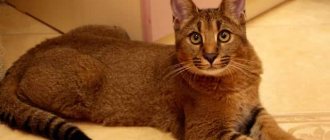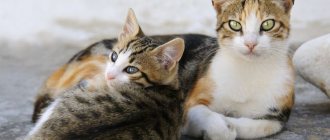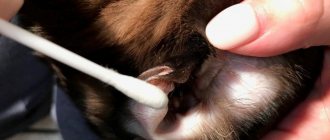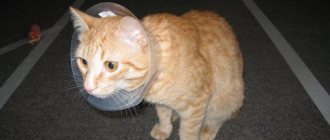What will you learn from the article?
- Origin story
- Appearance of a jungle cat
- Character
- Is it possible to keep a jungle cat at home?
- Health
- Caring for a jungle cat
- Feeding
- Where to buy a reed kitten?
Some become fans of the TV series House, while others enjoy the charm of the jungle cat, which is also called... yes, that's right - house. So, meet the jungle cat, aka house, aka swamp lynx or, scientifically, Felis chaus!
The jungle cat is a true predator that once lived in 25 countries. Nowadays, he lives only in zoos or in the apartments of his fans.
Origin story
In Russia, the jungle cat was previously found on the coast of the Caspian Sea, but was last seen in its traditional habitat in the 1980s (according to IUCN).
However, there were times when the wild jungle cat was by no means exotic, but a ubiquitous phenomenon. It is believed that the swamp lynx, which lives on the banks of the Nile, was the first to reach people about three thousand years ago.
People (ancient Egyptians), tried to get a lot of benefits from their acquaintance with the reed cat - the reed cat not only lived in their houses, but also went with game hunters. On the surviving scrolls you can see how Cat House hunts ducks and even swims to get prey from the river.
In fairness, it must be said that only the Egyptians were able to tame the wild purr; all subsequent historical evidence suggests that people avoided jungle cats, moreover, they considered them dangerous for their farms, in particular for domestic muskrats and pheasants, which were attacked predators. Therefore, there was a constant capture of wild cats, whose skin was in demand.
And although 9 subspecies of the reed cat are registered in the world today, in fact, you will not find a single one in the reeds!
Appearance of a jungle cat
Since the wild jungle cat is not a breed, there is, of course, no standard for it.
But Wikipedia can help us - a detailed description of the House in the publicly available multilingual universal Internet encyclopedia introduces the appearance of this representative of the cat world.
- The head of the Hausa is massive.
- The muzzle is elongated.
- The ears are large; adults have tufted ears. The ears on the reverse side are decorated with “false” eyes.
- Eyes yellow or green.
- Jungle cats, with fairly long paws, have a short thin tail, proportionally accounting for about a third of the body length.
- The body itself is powerful with a wide chest.
- The coat is smooth, short, very thick.
- Color is the main difference between those same 9 subspecies. But the main colors are black, ticked tabby/silver.
If you carefully study the photos of the houses, you will see that the color is uneven. The belly and tail are less pronounced in color than the head and back of the animal.
Sexual dimorphism is striking in this family. Males are always larger than females. Usually at the withers they reach half a meter, in length (including the tail) sometimes 124 cm.
The weight of an adult house is about 14 kg (a cat weighs less - up to 10 kg).
Breed Features
The jungle cat is by nature a wild animal . Maintaining, raising and caring for him at home is quite difficult. He is very different from domestic cats, not only in appearance, but also in character.
Important! The Hausa jungle cat should not be confused with the Hausi breed. The latter was specially bred by crossing a jungle cat and a domestic cat.
Description and photo of the cat
In the wild, cats live in Kazakhstan, Dagestan, Afghanistan, Pakistan, India, Iran, Iraq, Syria, Sri Lanka, Thailand, and Egypt. They can have different colors and sizes. The color of the coat can be from red to brown, gray-brown to black. It was based on their color that they were divided into 10 subspecies .
The back and head of the Hausa are darker than the belly and tail, and there are stripes on the legs and tail. The structure of the coat is smooth, short, very thick. In winter, like all animals, it gets even thicker. The head is quite large with large erect triangular ears set high, and the muzzle is elongated.
Adults have tufts on their ears, giving them a lynx-like appearance and giving them the nickname "swamp lynx". Large, almond-shaped eyes, usually green or yellow in color. A distinctive feature of the House is its long, muscular legs. And the tail is short, about a third of the body long, which is about 20-30 centimeters, with a black tip.
These are quite large representatives of the cat family. Males, which are an order of magnitude larger than females, can reach a length with a tail of 125 cm, a height at the withers of up to half a meter and weigh up to 15 kg. The smallest jungle cats live in Thailand and Sri Lanka. They can weigh from 4 kg and be from 75 cm in length.
In nature, Hausas live in swampy areas overgrown with reeds, impassable thickets of bushes, and on the outskirts of the forest. They do not like open places and do not climb trees. Swamp lynxes are excellent hunters .
They catch birds, small rodents, gophers, hares and even small wild pigs. They swim very well. In this way they get their own fish and hide from persecution. They prefer to hunt in the dark. This is done less often during the day in cool weather. The house cat meows, but much louder than other cats and as if with a “bass”. In February and early March, jungle cats mate. Males fight for the right to own a female, arranging fights among themselves. A little more than two months later, kittens are born. Usually there are from three to six of them in a litter, but sometimes up to ten. Babies have clearly visible stripes on their fur, which disappear as they grow.
On the tenth day, the kittens' eyes open, they feed on milk for up to three months, and at five they are already completely independent. As a rule, this is where their communication with relatives ends, since cats are loners by nature. Houses live up to 14 years.
Did you know? Native speakers of English call the jungle cat “jungle cat”, as well as “reed cat” (Jungle cat, Reed cat).
Animal character
In two words, the character of a Hausa can be described as follows: it is a cat that walks on its own . He has the temperament of a wild cat and is not aggressive unless touched. Otherwise, troubles cannot be avoided. The owners of real jungle cats said that in fights they caused serious damage to shepherd dogs and mastiffs. At the same time, they get along well with cats.
Swamp lynxes are predators by nature, so it is better not to play with them. For the same reason, people who have children should not have them . They are hunters, so all domestic animals such as birds and rodents face an unenviable fate. If such a pet lives in a private house, then there will definitely be no mice, rats, or birds on the territory. Even neighbors' dogs that suddenly run into the territory can be strangled.
We advise you to familiarize yourself with the ten most expensive cat breeds in the world.
Is it possible to keep a jungle cat at home?
A domestic jungle cat is a dubious pleasure. If you have excess furniture, wallpaper and ceiling, then immediately get such a pet and you will soon part with the excess. There is no point in keeping such a cat in an apartment, only in private property, and then it is advisable to build an enclosure.
But hybrids of a wild cat and a domestic cat are quite comfortable neighbors. Thus, a hybrid of a jungle cat and an Abyssinian cat, the famous Chausie, becomes completely domestic by the fourth generation, without, however, losing the distinctive features of their ancestors.
So, the reed cat is “a chisel, let’s not say where,” because it is mobile, active, ready for work and defense always, at any time of the day or night (especially at night!). Even after growing up, both Chausies and Houses remain kittens at heart. Dispersing the blood of their wild ancestors, they jump on everything they can jump on, climb everywhere they can reach and jump onto their hands with a running start. Considering their mass and size, this is a tangible pleasure!
However, jungle cats are also smart. Yes, they are easy to train, know how to follow commands and quite easily tolerate being around other pets.
In general, play some house music – you won’t be bored!
But don’t forget to buy a large tray, a scratching post, a country house and a pool in advance - after all, jungle cats love to swim and need free open space.
Choosing a kitten
Finding a real jungle kitten is not an easy task. They are bred only in nurseries, of which there are very few. You can also try to buy a kitten at an exhibition of elite breeds. If you finally make up your mind and find a kitten, ask the breeders to show its parents . You must make sure that they are indeed real jungle cats.
The type of pedigree papers that must accompany the kitten will only mean something to you and a certain circle of people who are involved in Houses. This is because the breed is considered wild and is not recognized by any of the clubs and federations. The price of a baby jungle cat is “biting”. It starts at five thousand dollars, but according to other sources, the bill goes into tens of thousands for a real Hausa.
Look carefully at the kitten, it should be active and playful. The coat and eyes should look good. Mother and kittens must be well-groomed. By the time you decide to take the baby, he should be treated with helminths and given the necessary vaccinations. As a rule, this is done before three months of age. We must remember that this is a wild animal. You can win over the baby by picking him up as early as possible.
Did you know? Jungle cat kittens are born with stripes that disappear with the onset of puberty: natural camouflage for the period until the animals can fend for themselves.
Caring for a jungle cat
The animal is large and agile. Due to the risk of injury and the stress on the skeleton, the jungle cat's joints should be checked regularly. Do not forget to get vaccinated, because, despite a good gene supply, the swamp lynx is susceptible to common cat diseases.
Give the house the opportunity to swim at will. A swimming pool is suitable for this, ideally if there are fish splashing in it.
To make your domestic jungle cat look like its wild counterparts look in the photo, you do not need to specifically bathe the jungle cat, but you will have to comb it periodically.
Diseases and health
House is not susceptible to diseases at the genetic level. He has hereditary wonderful health. But when kept in an enclosure, some problems are possible.
Possible diseases
As a rule, cats do not get sick . Occasionally, deviations are possible that are associated with low mobility and improper feeding. This could be joint disease, digestive system problems or obesity. To prevent them, you need to pay a lot of attention to walks with your pet and balance your diet. Jungle cats can suffer from viral diseases, which are prevented by vaccinations given to kittens.
Feeding
In nature, Hausas do not eat porridge. Therefore, you should not offer them a cereal menu at home. But live food, no matter how humane it may be, will have to be fed to the jungle cat every day. After all, what does a jungle cat ideally eat? That's right, game.
The traditional daily diet of an ex-savage looks like this: 200 grams of lean meat plus a couple of live mice (or one rat). As an alternative, high quality Orijen cat food (link to the official website).
Care and care
The diet of jungle cats is quite specific. Ready-made dry food is absolutely not suitable for them - raw meat is required. From time to time, it is advisable to give live food - mice, rats (of course, not in front of children.) Once a week, to prevent obesity, you need to arrange a day of fasting: when kept at home, swamp cats spend much less energy than in the wild. To maintain good shape, they need ultraviolet light: in their natural environment, marsh lynxes often bask in the sun.











